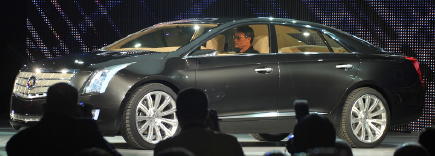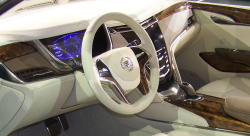Back in the early 2000s Cadillac excited driving enthusiasts by pledging to become a world-class luxury car manufacturer by spending billions to develop all-new rear wheel-drive cars that shared little with other General Motors product. Problem was, aside from the CTS these new models sold poorly, and GM ran out of money.
So, for at least the next five years, and probably longer, Cadillac will be redirecting its focus to the more traditional luxury car buyers that have historically purchased its cars. Though a rear-wheel-drive “Alpha” platform compact sedan is reportedly still on the way, other Cadillacs will be based on front-wheel-drive platforms. The 2010 SRX was the first of these products. The 2012 XTS, introduced in concept form at the 2010 NAIAS, will be the next.
For the past few years Cadillac has wavered among a number of different ways to replace the slow-selling STS rear-wheel-drive sedan and outmoded DTS front-wheel-drive sedan. When the money ran out, a rear-drive replacement was shelved, and the XTS received the green light.

Early word was that the XTS would be based, like most other recent GM mid-size and up sedans, on the Epsilon platform. In some iterations this platform doesn’t translate to a roomy interior, but GM pledged that the Cadillac variant would be larger.
How much larger? Well, while the XTS shares its 101.7-inch wheelbase with the 2010 Buick LaCrosse, the largest Epsilon-based sedan offered to date, it’s over half a foot longer (203.5 inches) and nearly two inches wider (74.8 inches). And to the eye the difference between the two cars appears even larger, courtesy of the Cadillac’s squarer lines. Compared to the DTS, the XTS is four inches shorter in both wheelbase and length but just as wide. Add in more upright side windows and an interior designed to maximize perceived room, and the XTS should feel roomy inside.
 I wanted to check this out at the show, but when I asked if I could sit in it the Cadillac designer said, “We’d prefer not.” This was a one-off prototype, and potentially fragile.
I wanted to check this out at the show, but when I asked if I could sit in it the Cadillac designer said, “We’d prefer not.” This was a one-off prototype, and potentially fragile.
Clearly, the XTS is much more a direct replacement for the DTS than for the STS. Cadillac clearly intends it as a luxury sedan, and not a sport sedan. Aside from the platform, the styling is much more conservative than the CTS and STS. The most radical element: headlights that extend nearly halfway to the A-pillar.
In fact, my first thought upon seeing the XTS was “Cadillac Avalon.” Like the XTS, Toyota’s Avalon is based on a modest midsize family car platform that has been expanded as much as possible and given more upscale, more conservative styling. Both cars are aimed at traditional luxury buyers, though the Avalon isn’t nearly as fancy inside–or as pricey. Perhaps because the targets are similar, and both seek to maximize interior room, the car’s basic shapes are similar.
In a departure from both the STS and the DTS, no V8 will be offered in the XTS. The concept car had a 3.6-liter hybrid powertrain, and a non-hybrid 3.6 as used in the CTS and LaCrosse is virtually a given. Perhaps there will be a turbo V6 to go up against Lincoln’s MKS EcoBoost. But, as with the Lincoln, handling won’t be much of a priority.
The 2012 Cadillac XTS will probably strongly appeal to traditional luxury sedan buyers–reaction was positive at the show–so in this sense it will probably be a success. It’s just not nearly as dramatic as the hardcore “art and science” Cadillacs, and as a driving enthusiast I’m saddened by Cadillac’s current direction.